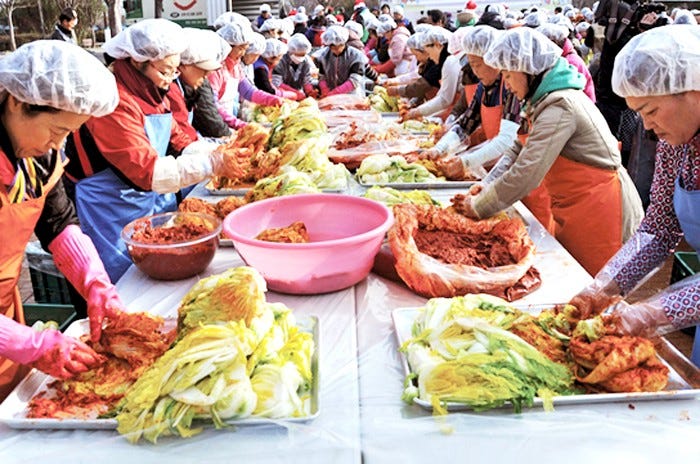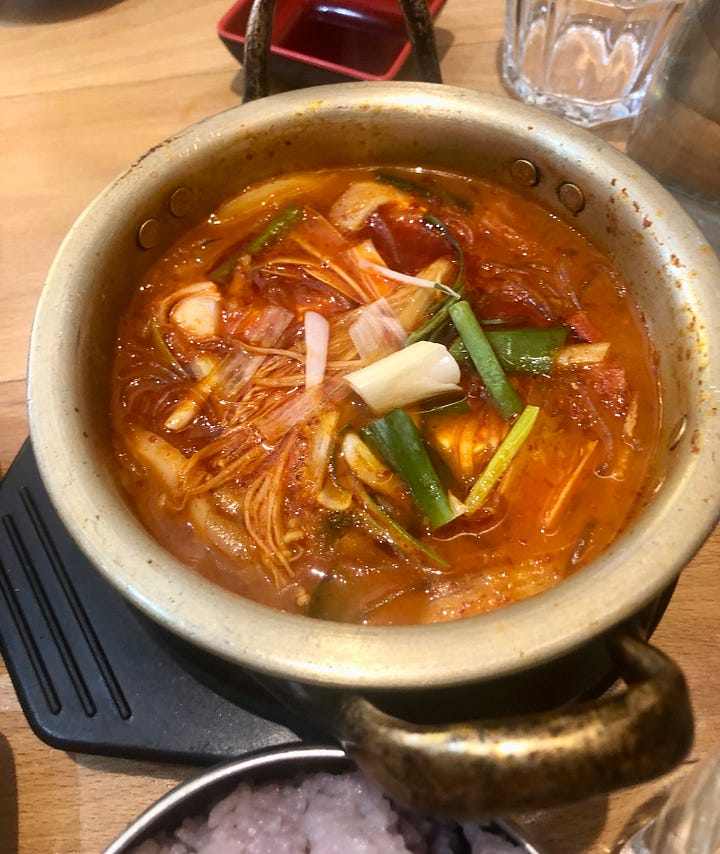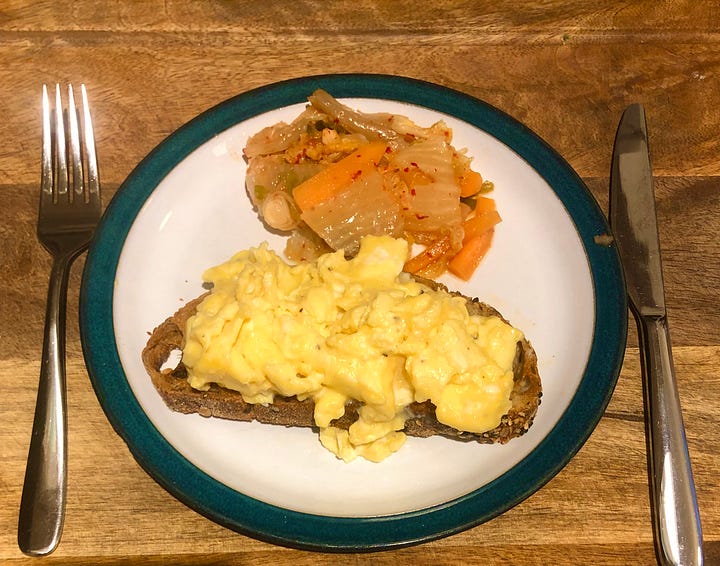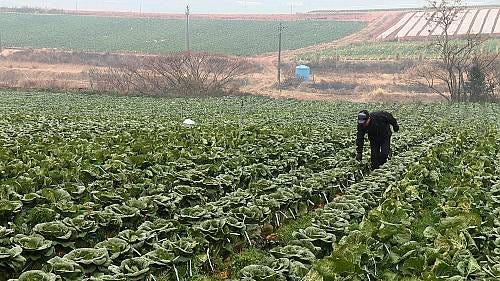Pickle power
Korea's national dish of kimchi, fermented cabbage, is just the most pungent part of the Korean wave of cultural imports sweeping the world. Plus: what I've been drinking this week




IF, 20 years ago, you had predicted that a South Korean boy band would easily sell out Wembley stadium, and shift over 40 million albums of Korean-language songs worldwide; or that a Korean thriller-drama would attract two million British viewers and be the top Netflix show in 94 countries, people might have looked at you a bit strangely.
Then again, if you’d told them that the Korean national dish of spicy cabbage pickle would be turning up in their local Sainsbury’s and in pub menus, they would have been equally bemused. For kimchi is every bit as Korean – and as, well, odd – as pop stars BTS and hit show Squid Game.
Such is the strength of hallyu, the Korean wave of culture that has swept first Asia, from the late 1990s, and in the last decade the rest of the world too. Driven in large part by the rise of social media and the internet, Korea’s cultural exports go beyond K-pop and K-drama, and now far beyond east Asia too. Korean TV dramas have proved wildly popular in India and in parts of the Arab world, while Korean manhwa (manga comics) and animated “webtoons”, film (Parasite) and gaming have also gained an international following. Indeed the hallyu phenomenon inspired a V&A Museum exhibition last year.
Part of the second, global phase - “Hallyu 2.0” - has been deliberate gastro-diplomacy by the South Korean government. True, you’d have difficulty teasing out the precise relationship between its “Taste of Korea” campaign and the advent of ASDA Korean Style BBQ crisps. But by whatever means, Korean food has arrived, with bold, spicy flavours to appeal to many modern British palates.
And it is inevitable that kimchi should be a key part of that wave. It’s a cornerstone of Korean culture, served with every meal – which is why annual consumption in South Korea is around 40kg a head.
That’s a lot of cabbages – but also daikon (aka mooli), the large Asian radish that is the second-most-popular type of kimchi in South Korea. Indeed there are reportedly more than 160 different types of kimchi according to their different ingredients and the time of year they’re eaten. As a Korean saying has it, “if you have kimchi and rice, you have a meal.” But Napa cabbage remains the classic and most ubiquitous, baechu kimchi.
Pickled vegetables have played a central role in the Korean diet since antiquity: it’s a cold country in winter, and up until the 1960s was a very poor one too. But while there are references to pickles in ancient classical Korean literature, the more recent ingredient of most kimchi is Korean sun-dried red chilli (gochu). Though some Koreans claim that chillis always grew there, this would defy basic botany: all capiscums are native to the Americas. In fact the first literary reference to chillis in Korea is in the early seventeenth century: there is speculation that Portuguese traders could have introduced them.
Today, two thirds of the UK’s 45,000 Koreans live in London – and it certainly feels as though a good portion of those live in New Malden, on the south-western edge of the capital. Other than the profusion of Korean stores and restaurants, New Malden remains the kind of suburb favoured by people who find Wimbledon too edgy. But it’s well worth a visit for the food at simple joints such as Imone, where Korean families gather around tables crammed with banchan, small side dishes including, of course, kimchi.
New Malden also hosts an annual kimjang festival at the end of October. Kimjang (or gimjang) is the annual communal making of cabbage kimchi before winter, one of the biggest Korean holiday seasons and now listed by UNESCO as an intangible cultural heritage. For the only true way to understand and enjoy kimchi is to make your own - and I do find it quite addictive.
I am indebted to chef and food educator Clare Heal both for teaching me about fermentation and pickling in her excellent Borough Kitchen cooking class – and for allowing me to reproduce here her very good and simple kimchi recipe. Check out her interesting Substack blog as well.
Clare’s ‘Mak’ Kimchi
Kimchi is traditionally made with quartered cabbage, but this needs brining for a long time. Chopping the cabbage first makes the process quicker. “Mak” means “quick” or “careless”, and this comes together easily (but is still delicious).
Ingredients
1 head Chinese (Napa) cabbage
30g flaky sea salt
100g daikon (approx 1/3), cut into batons
1 carrot, cut into batons
10g glutinous rice flour (from East Asian stores)
6 cloves garlic, peeled and crushed
1/2-inch piece of ginger, peeled and minced
4 spring onions, finely sliced
1 tsp sugar
3 tbsp Asian fish sauce
1-2 tbsp gochugaru Korean chilli flakes
Makes enough for a 750ml jar
Method
1. First make sure your jar and its lid are clean. The easiest way is to put it through a dishwasher
2. Remove the root from the cabbage then slice it in half through the white part, stopping about halfway up where the leaves begin to get frilly. Get your thumbs into the opening and pull the cabbage in half. Use the same method to divide lengthwise into quarters.
3. Slice the cabbage quarters into bite-size pieces (approximately 2 inches). Put the pieces in a bowl along with the batons of carrot and daikon, toss with the salt and set aside for 90 minutes to 2 hours. Occasionally toss again to make sure all bits of veg get equal exposure to the brine which is produced.
4. Meanwhile put the glutinous rice flour in a pan and measure 80ml cold water. Mix in a little of the water to create a paste and when there are no lumps add the rest and bring to a boil over a medium heat. It will thicken and look like wallpaper paste. Set aside to cool.
5. Once the rice flour paste is cool, put 2 tbsp of it in a small bowl and add the ginger, garlic, spring onion, sugar, fish sauce and gochugaru (add more or less to taste).
6. Drain the cabbage in a colander over the sink and give it a quick rinse. Return it to the bowl and add the chilli paste. Gently massage the leaves until it is evenly distributed. Pack into a jar along with any liquid remaining in the bowl.
Use the root or a pickle weight to keep everything under the brine and seal the jar. Place the jar on a plate or tray to catch any leakage and leave at room temperature, out of direct sunlight.
7. Check the kimchi every day, opening the jar to let the gas escape and tasting a little bit (it will start to bubble after about a day.) When it has stopped bubbling (5-7 days) move it to the fridge. This won’t stop the fermentation but will slow it right down. The kimchi will keep in the fridge indefinitely.
What I’ve been drinking this week
Gulfi “Valcanzjria” 2020, IGT Sicilia - this is an unusual blend of Chardonnay and Carricante, the best-known white grape of Mount Etna. I like the way that despite the Etna grape being less than 10 per cent of the blend, its trademark brisk minerality shines through, against the fruitier, more generous Chardonnay. Lovely (Sociovino, Bottle Apostle, Classic Car Bar, from £20.75. XtraWine has the 2022 at £15.36.)
Aurora 2022 Rosso Piceno - Rosso Piceno is little known in the UK though it’s the biggest denominazione of the Marche, the region bordering Adriatic in central Italy, immediately east of Umbria and north of the Abruzzo. Its reds are blends of Sangiovese with the big grape of the Abruzzo, Montepulciano; this has a bit of Cabernet Sauvignon it it too. It’s dark, spicy, with dusty tannins and a slight tang: tasty and quite interesting, though a little pricey for what it is. This one is better value when drunk in-store at Yield N1, as I did - a good little Highbury neighbourhood wine bar with a fine selection of mostly more natural wine (Buon Vino, Yield N1, Passione Vino, Cave Bristol, from £22.)
The Society’s Exhibition Margaret River Cabernet Sauvignon 2021, Western Australia - this nice Cab is a snip while on sale from the Wine Society. Made by noted producer Vasse Felix, it’s in a juicy, accessible style but nevertheless quite serious: juicy blackcurrant fruit with good acidity, hints of tobacco and leather and some length (The Wine Society, reduced to £13.95 from £17.)





Thanks for the shout out, Andy. Happy to hear you’re still fermenting away…